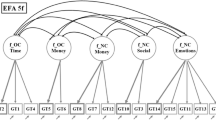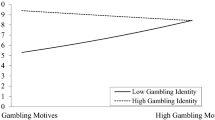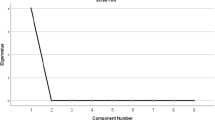Abstract
The present research describes the proposal and validation of three gambling outcome measures, the Gambling Quantity and Perceived Norms Scale (GQPN), the Gambling Problem Index (GPI), and the Gambling Readiness to Change Questionnaire (GRTC).The study consisted of 560 undergraduate college students who completed a survey including the newly constructed measures and other measures designed to assess convergent validity. Results confirmed good reliability and convergent validity of all three measures. Implications for evaluating efficacy of treatment and prevention interventions are detailed.
Similar content being viewed by others
REFERENCES
American Psychiatric Association. (1980). Diagnostic and statistical manual of mental disorder (3rd ed.). Washington, DC: American Psychiatric Association.
Beaudoin, C. M., & Cox, B. J. (1999). Characteristics of problem gambling in a Canadian context: A preliminary study using a DSM-IV-based questionnaire. Canadian Journal of Psychiatry, 44(5), 483–487.
Bland, R. C., Newman, S. C., Orn, H., & Stebelsky, G. (1993). Epidemiology of pathological gambling in Edmonton. Canadian Journal of Psychiatry, 38(2), 108–112.
Blaszczynski, A., Dumlao, V., & Lange, M. (1997). “How much do you spend gambling?” Ambiguities in survey questionnaire items. Journal of Gambling Studies, 13(3), 237–252.
Breen, R. B., & Zuckerman, M. (1999). ‘Chasing’ in gambling behavior: Personality and cognitive determinants. Personality and Individual Differences, 27(6), 1097–1111.
Christiansen, E. M. (1998). Gambling and the American Economy. The Annals of the American Academy of Political and Social Science, 555, 36–52.
Cunningham-Williams, R. M., Cottler, L. B., Compton, W. M., & Spitznagel, E. L. (1998). Taking chances: Problem gamblers and mental health disorders: Results from the St. Louis Epidemiologic Catchment Area study. American Journal of Public Health, 88(7), 1093–1096.
Derevensky, J. L & Gupta, R. (2000). Prevalence estimates of adolescent gambling: A comparison of the SOGS-RA, DSM-IV-J, and the GA 20 Questions. Journal of Gambling Studies, 16(2- 3), 227–251.
Dickerson, M., & Baron, E. (2000). Contemporary issues and future directions for research into pathological gambling. Addiction, 95, 1145–1159.
Dickerson, M., Hinchy, J. & Fabre, J. (1987). Chasing, arousal and sensation seeking in off-course gamblers. British Journal of Addiction, 82,(6), 673–680.
DiClemente, C. C., Story, M., & Murray, K. (2000). On a roll: The process of initiation and cessation of problem gambling among adolescents. Journal of Gambling Studies, 16(2- 3), 289–313.
Dimeff, L. A., Baer, J. S., Kivlahan, D. R., & Marlatt, G. A. (1999). Brief Alcohol Screening and Intervention for College Students. New York: Guilford Press.
Dube, D., Freeston, M.H., & Ladouceur, R. (1996). Potential and probable pathological gamblers: Where do the differences lie? Journal of Gambling Studies, 12(4), 419–430.
Frank, M.L., Lester, D. & Wexler, A. (1991). Suicidal behavior among members of Gamblers Anonymous. Journal of Gambling Studies, 7(3), 249–254.
Gupta, R., & Derevensky, J. L. (2000). Adolescents with gambling problems: From research to treatment. Journal of Gambling Studies, 16(2- 3), 315–342.
Joseph, J., Breslin, C., & Skinner, H. (1999). Critical perspectives on the transtheoretical model and stages of change. In J. A. Tucker, D. M. Donovan, & G. A. Marlatt (Eds.), Changing Addictive Behavior (pp. 160–190). New York: Guilford Press.
Korn, D.A. & Shaffer, H. J. (1999). Gambling and the health of the public: Adopting a public health perspective. Journal of Gambling Studies, 15(4), 289–365.
Kuhn, T. S. (1970). The structure of scientific revolutions (2nd ed.). Chicago: University of Chicago Press. (Originally published 1962)
Ladouceur, R., Bouchard, C., Rheaume, N., Jacques, C., Ferland, F., Leblond, J., & Walker, M. (2000). Is the SOGS an accurate measure of pathological gambling among children, adolescents and adults? Journal of Gambling Studies, 16, 1–24.
Ladouceur, R. Dube, D., & Bujold, A. (1994). Prevalence of pathological gambling and related problems among college students in the Quebec metropolitan area. Canadian Journal of Psychiatry, 39, 289–293.
Lesieur, H. R., & Blume, S. B. (1987). The South Oaks Gambling Screen (SOGS): A new instrument for the identification of pathological gamblers. American Journal of Psychiatry, 144, 1184–1188.
Lesieur H. R. & Blume, S. B. (1991) Evaluation of patients treated for pathological gambling in a combined alcohol, substance abuse and pathological treatment unit using The Addiction Severity Index. British Journal of Addiction, 86, 1017–1028.
Lesieur, H. R., Cross, J., Frank, M., Welch, M., White, C. M., Rubenstein, G, Moseley, K., & Mark, M. (1991). Gambling and pathological gambling among university students. Addictive Behaviors, 16, 517–527.
Lester, D. (1998). Legal gambling and crime. Psychological Reports,83(1), 382.
Marlatt, G. A., Baer, J. S., Kivlahan, D. R., Dimeff, L. A., Larimer, M. E., Quigley, L. A., Somers, J. M., & Williams, E. (1998). Screening and brief intervention for high-risk college student drinkers: Results from a two-year follow-up assessment. Journal of Consulting and Clinical Psychology, 66, 604–615.
McLellan, A. T., Luborsky, L., Woody, G. E., & O'Brien, C. P. (1980). An improved diagnostic evaluation instrument for substance abuse patients: The Addiction Severity Index. The Journal of Nervous and Mental Disease, 168, 26–33.
Miller, W. R., & Rollnick, S. (1991). Motivational Interviewing: Preparing People for Change. New York: Guilford Press.
Moore, S.M. & K. Ohtsuka (1999), The prediction of gambling behavior and problem gambling from attitudes and perceived norms. Social Behavior and Personality, 27 (5): 455–466.
Prochaska, J. O., & DiClemente, C. C. (1986). Toward a comprehensive model of change. In W. R. Miller & N. Heather (Eds.), Treating addictive behaviors: Processes of change (pp. 3–27). New York: Plenum Press.
Rollnick, S., Heather, N., Gold, R., & Hall, W. (1992). Development of a short “readiness to change” questionnaire for use in brief, opportunistic interventions among excessive drinkers. British Journal of Addiction, 87, 743–754.
Shaffer, H. J., Hall, M. N., & Vander Bilt, J. (1997). Estimating the prevalence of disordered gambling behavior in the United States and Canada: A meta-analysis. Harvard Medical School, Division on Addictions.
Sharpe, L., & Tarrier, N. (1992). A cognitive-behavioral treatment approach for problem gambling. Journal of Cognitive Psychotherapy: An International Quarterly, 6, 193–203.
Ursua, M. P., & Uribelarrea, L. L. (1998). 20 questions of Gamblers Anonymous: A psychometric study with population of Spain. Journal of Gambling Studies,14, 3–15.
Volberg, R. A. (1994). The prevalence and demographics of pathological gamblers: implications for public health. American Journal of Public Health, 84, 237–241.
Volberg, R. A., & Steadman, H. J. (1988). Prevalence estimates of pathological gambling in NJ and MD. American Journal of Psychiatry, 146, 1618–1619.
White, H. R., & Labouvie, E. W. (1989). Towards the assessment of adolescent problem drinking. Journal of Studies on Alcohol, 5, pp 30–37.
Author information
Authors and Affiliations
Corresponding author
Rights and permissions
About this article
Cite this article
Neighbors, C., Lostutter, T.W., Larimer, M.E. et al. Measuring Gambling Outcomes Among College Students. J Gambl Stud 18, 339–360 (2002). https://doi.org/10.1023/A:1021013132430
Issue Date:
DOI: https://doi.org/10.1023/A:1021013132430




